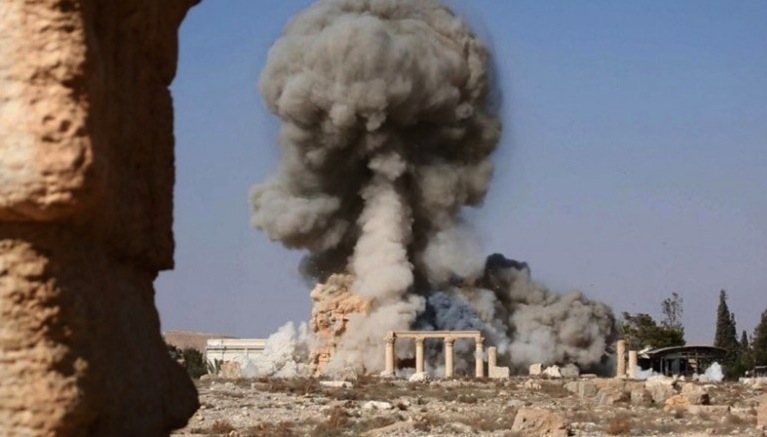We know that the Islamic State or ISIS or ISIL or Daesh, or whatever we want to call these organised Islamist mass-murderers, are interested in at least two things: money and culture. The former they want to accumulate and the latter they want to destroy. Before the attacks in Paris, the culture that IS took pleasure in destroying belonged largely to the rich legacy of Mesopotamia and its ancient history. We know that 2,000-year-old Greco-Roman temples and structures, many from the city of Palmyra, have fallen to IS explosives. We know that Assyrian sculptures going back at least ten centuries BC have fallen to IS sledgehammers, and much else. Yes, Assad’s warplanes and Western policymakers can take some blame for this violent, contemporary rocking of the cradle of civilisation. There’s much fault to go around.
But the Islamic State’s theologically inspired iconoclastic zeal sets it apart from other contemporary fundamentalist movements. The destruction of culture is not well stomached by what we like to call the West, which, whether or not it is as idolatrous as its new Islamist foil would have it, goes to great lengths to house and protect both its own and others’ material history (fully acknowledging that many of the West’s ‘treasures’ came from colonial looting campaigns). This is part of the problem, however, because the Islamic State is interested in money too, and one of the ways we know it gets its money is by not quite destroying all of those antique sites and artefacts it appears to stomp across and instead selling them into the market, black though it may be.
We must accept then, too, that all of the immediately public and spectacularised images that IS distributes of its minions jackhammering and blowing up UNESCO heritage and other cultural sites in the Euphrates River Valley are meant not only to raise the West’s defence-of-history-and-liberal-values ire, but also to prime the West’s chequebook. The uploaded videos and media coverage of IS’s archaeological calamities are just the lead generators of its antiquities marketing and sales group, whose target customer is the insatiable Western collectorate, with its love of culture and of universal history, which, by the way, far outstrips the ambivalent moral cringe that hits its face when viewing wave upon wave of Syrian and Iraqi refugees breaking on the beaches of Europe and dampening the gates at JFK.
Back in February, the UN – not exactly the quickest-off-the-line of the world’s governing bodies – passed a resolution (2199) ‘noting with concern’ that ‘ISIL’ and the ‘Al-Nusrah Front’ were using looted cultural heritage to fund their activities, and called on member states and UNESCO to take steps to monitor and shut down illegal cross-border trade in artefacts removed from Iraq (since 1990) and Syria (since 2011). Then in August, the Federal Bureau of Investigation issued a warning to antiquities dealers in the US not to be so much as caught downwind of these artefacts, lest they find themselves unwitting sponsors of terrorism, with all the conspicuous lack of rights and privileges that comes with that accolade.
I don’t have the numbers, but I am not so cynical as to think that these and related actions by international agencies that issue guns to their foot soldiers have had little effect on the market for looted antiquities. My guess is that revenues from loot are down. It’s unclear whether trade in oil or hostages, Islamic State’s two other ugly sources of income, are making up for the falloff.
Then came Paris.
Whatever else they were, the attacks in Paris in November were murderous assaults against everyday people, most of whom were taking part in ‘culture’. Whether that culture is specifically ‘Western’ is largely beside the point. Attending a concert, going out to dinner or a football match – these are cultural pursuits, part of the habitus of human life, which finds great utility in such intimate and collective social engagements, even more so today as part of the ever-growing ‘experience economy’.
Many political and security observers noted that the Islamic State’s indiscriminate mass-murder of both French and international citizens marked a turning point in its strategy, which before 13 November had largely looked like some nightmarishly Hobbesian attempt at statecraft. The move into spectacularised murder was not something new, either, as anyone who has witnessed Islamic State’s videos of mass beheadings will recognise. But the Paris attacks had none of the Islamic fundamentalist specificity as did, say, the murder rampage a week later in Mali, where gunmen allegedly freed hostages who could recite verses from the Koran and murdered those who couldn’t. In Paris, culture was a target.
The question is: to what end? The lesson of Islamic State’s campaign of visibly and menacingly reducing the supply of antiquities in order to up their demand and so Islamic State’s revenues needs to be well learned here. It would be a mistake to see Paris as a merely symbolic lashing-out of a religiously psychopathic political player in its geopolitical adolescence, unless we want to understand that lashing-out as having been brought on by the West’s effective cancelling of one of IS’s credit cards. Nevertheless, Paris had a purpose. It may be larger, and more abstract, as the experience of culture, and the culture of experience, often are, but Islamic State’s new terrorism export isn’t, or isn’t solely, iconoclastic. To what end Paris? Follow the money.
This article was first published in the January & February 2016 issue of ArtReview.
